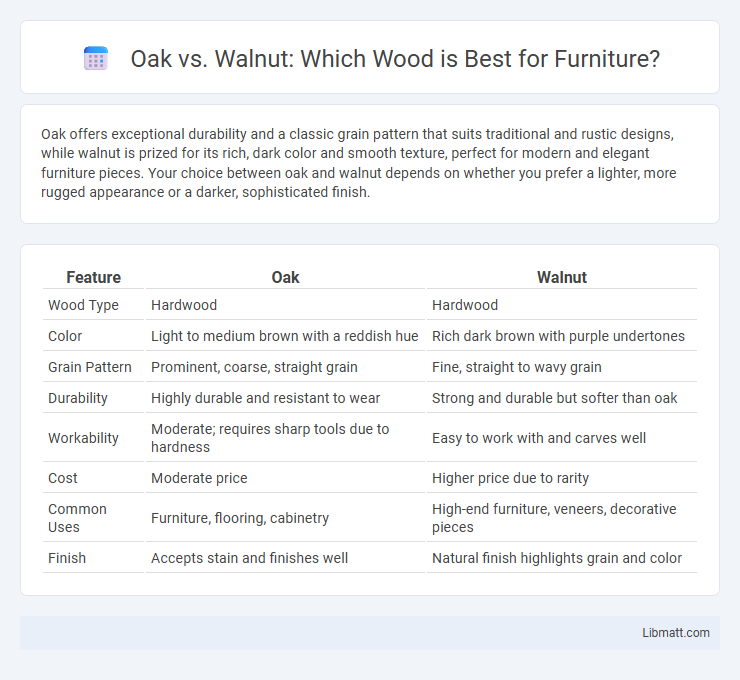Oak offers exceptional durability and a classic grain pattern that suits traditional and rustic designs, while walnut is prized for its rich, dark color and smooth texture, perfect for modern and elegant furniture pieces. Your choice between oak and walnut depends on whether you prefer a lighter, more rugged appearance or a darker, sophisticated finish.
Table of Comparison
| Feature | Oak | Walnut |
|---|---|---|
| Wood Type | Hardwood | Hardwood |
| Color | Light to medium brown with a reddish hue | Rich dark brown with purple undertones |
| Grain Pattern | Prominent, coarse, straight grain | Fine, straight to wavy grain |
| Durability | Highly durable and resistant to wear | Strong and durable but softer than oak |
| Workability | Moderate; requires sharp tools due to hardness | Easy to work with and carves well |
| Cost | Moderate price | Higher price due to rarity |
| Common Uses | Furniture, flooring, cabinetry | High-end furniture, veneers, decorative pieces |
| Finish | Accepts stain and finishes well | Natural finish highlights grain and color |
Introduction to Oak and Walnut
Oak and walnut are popular hardwoods prized for their durability and distinctive grain patterns, commonly used in furniture and flooring. Oak features a coarse texture with prominent rays and pores, offering a light to medium brown color with hints of yellow or red. Walnut is known for its rich, dark brown hue with a fine, straight grain, making it a preferred choice for high-end cabinetry and decorative veneers.
Key Differences Between Oak and Walnut
Oak features a coarse texture with prominent grain patterns, while walnut boasts a smoother surface and rich, dark brown color with purple hues. Oak is typically harder and more durable, ideal for heavy-use furniture, whereas walnut is prized for its fine finish and is often used in high-end cabinetry and decorative pieces. The cost of walnut generally exceeds that of oak due to its rarity and luxurious appearance.
Appearance and Grain Patterns
Oak showcases a prominent, coarse grain with open pores, offering a rugged texture and light to medium brown hues ideal for rustic and traditional designs. Walnut features a smooth, fine grain with tight, closed pores, displaying rich, dark brown to purplish tones that enhance luxurious and modern interiors. Your choice between Oak and Walnut will influence the visual warmth and style of your woodworking or furniture project based on these distinct appearance and grain characteristics.
Durability and Hardness Comparison
Oak and walnut exhibit distinct differences in durability and hardness, with oak ranking higher on the Janka hardness scale at approximately 1,290 psi compared to walnut's 1,010 psi. This makes oak more resistant to dents and scratches, ideal for high-traffic flooring and heavy-use furniture. Your choice depends on the balance between oak's superior toughness and walnut's moderate hardness coupled with its rich aesthetic appeal.
Color Variations in Oak and Walnut
Oak wood exhibits a wide range of color variations, typically ranging from pale beige to light brown with subtle reddish or yellow undertones, depending on the species such as red oak or white oak. Walnut is known for its rich, dark hues, often featuring a deep chocolate brown base with occasional purplish or grayish streaks that enhance its luxurious appearance. The distinct color ranges in oak and walnut significantly influence their suitability for various design styles, with oak providing a lighter and more versatile palette while walnut offers a striking, elegant contrast.
Workability and Ease of Use
Oak offers superior workability with its coarse grain and firmness, making it easier to cut, shape, and finish for various woodworking projects. Walnut, while slightly softer and smoother, provides excellent ease of use for intricate detailing but may require more careful handling to avoid dents. Your choice depends on the balance between durability and the level of precision needed for your project.
Common Applications and Uses
Oak is widely used in flooring, furniture, cabinetry, and wine barrels due to its durability and attractive grain patterns. Walnut is prized for high-end furniture, intricate woodworking, gunstocks, and decorative veneers because of its rich color and smooth texture. Your choice between oak and walnut should consider the specific application, balancing strength with aesthetic appeal.
Price and Availability
Oak is generally more affordable and widely available due to its abundance and faster growth rate, making it a cost-effective choice for furniture and flooring projects. Walnut, prized for its rich color and durability, commands a higher price and is less commonly found in local markets, often requiring specialty suppliers or custom orders. Availability varies regionally, with oak being more accessible in North America and Europe, while walnut is rarer and considered a premium hardwood.
Maintenance and Longevity
Oak wood offers excellent durability with moderate maintenance, requiring regular cleaning and occasional sealing to maintain its resistance to moisture and wear. Walnut, known for its rich color and natural oils, demands less frequent sealing but benefits from gentle cleaning to preserve its lustrous finish over time. Your choice between oak and walnut will impact the ease of upkeep and the lifespan of your furniture or flooring, with oak typically providing a longer-lasting, maintenance-friendly option.
Choosing the Right Wood: Oak vs Walnut
Oak offers durability and a prominent grain pattern ideal for traditional and rustic furniture, making it well-suited for high-traffic areas and heavy-use applications. Walnut provides a rich, dark color and smooth texture, favored for elegant, high-end pieces that emphasize aesthetics and fine craftsmanship. Selecting between oak and walnut depends on the desired balance of strength, appearance, and budget, with oak typically being more cost-effective and walnut considered a luxury hardwood.
Oak vs Walnut Infographic

 libmatt.com
libmatt.com